Analysis of Influenza Vaccination for Healthcare Workers and Patients
VerifiedAdded on 2022/09/28
|9
|2200
|19
Report
AI Summary
This report analyzes the effectiveness of influenza vaccination among healthcare workers, focusing on its role in controlling the spread of infectious diseases, particularly in elderly patients. The report synthesizes evidence from multiple studies, including randomized control trials and cross-sectional studies, to evaluate the impact of vaccination on influenza incidence, respiratory infections, and mortality rates. It examines the importance of vaccination in healthcare settings to protect both healthcare workers and patients. The report highlights the significance of addressing misconceptions about influenza vaccination among healthcare professionals and emphasizes the need for comprehensive public health initiatives to promote vaccination and prevent the transmission of influenza. The analysis includes a discussion of study limitations, such as the absence of control groups and potential selection bias, and it concludes with a strong endorsement of influenza vaccination as a key strategy for protecting vulnerable populations in healthcare environments.
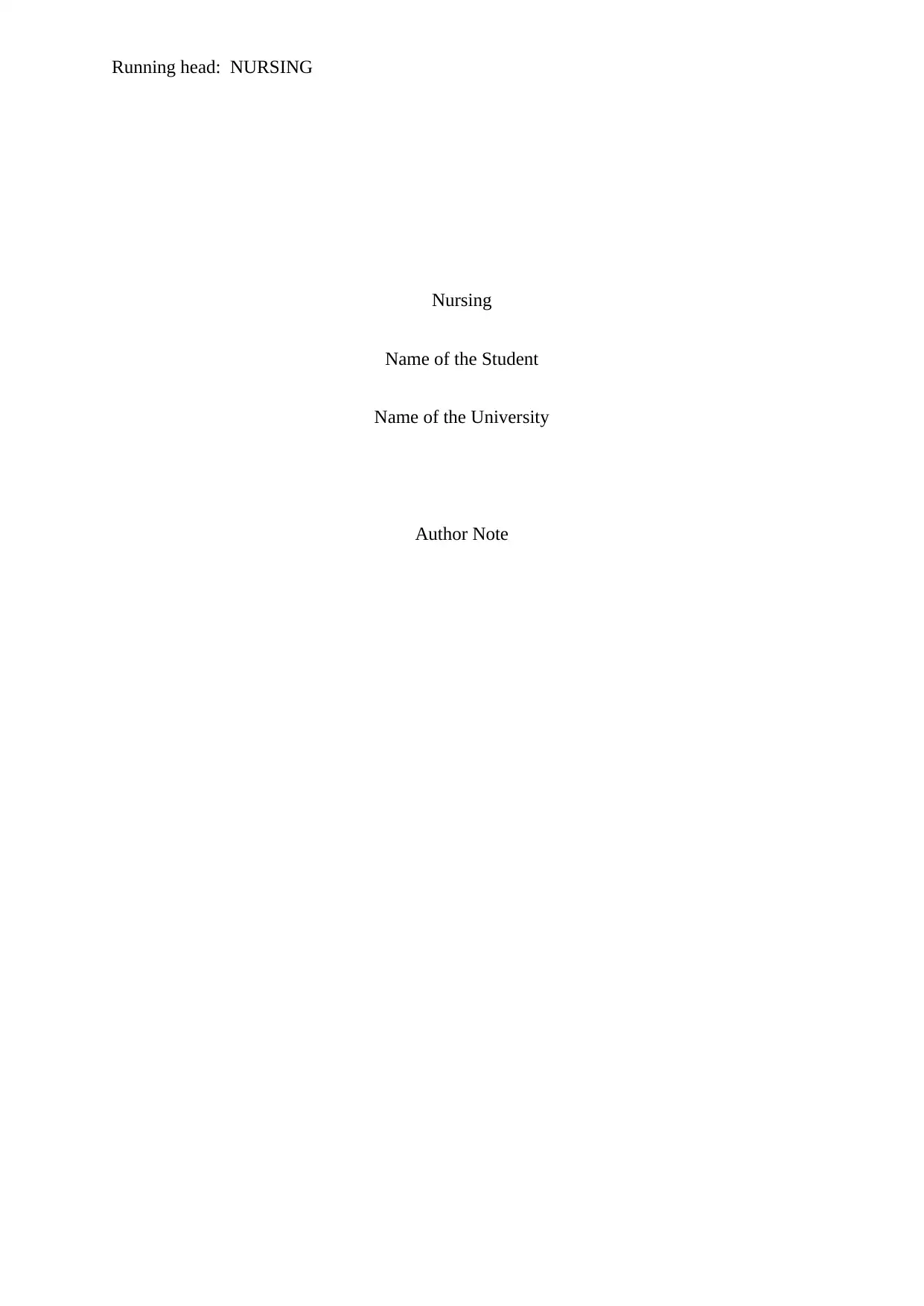
Running head: NURSING
Nursing
Name of the Student
Name of the University
Author Note
Nursing
Name of the Student
Name of the University
Author Note
Paraphrase This Document
Need a fresh take? Get an instant paraphrase of this document with our AI Paraphraser

1
NURSING
Evidence 1
Potter et al. (1997), describes about the importance of influenza vaccination and its
significance in reduction of incidences of influenza in elderly people. Elderly adults often
suffered with several chronic disorders, which have a direct impact on their immunity system.
As a result, even if they are vaccinated, the efficiency of the vaccine was not adequate
enough to prevent influenza. The center for drugs control and prevention recommended the
vaccination of healthcare workers as an strategy to reduce influenza. The study aims to find
the efficacy of the strategy.
The study was conducted in 12 different long term care hospitals in Glassglow, where
around 1059 patients were participated. The hospitals played important role in implementing
the policies related to vaccination. Health care workers were provided with random
vaccination. The patients and Health care workers were grouped under four categories such
as staff and patient both unvaccinated, staff vaccinated and patient unvaccinated, staff
unvaccinated and patient vaccinated and staff and patient both vaccinated. Around 653
healthcare workers agreed to receive vaccine. The primary detection was made by Brathel
activities of daily living index. The detection of influenza was measured by blood samples,
which were collected from patients before vaccination and after the study. The samples were
analyzed only for unvaccinated groups of patients. The infection was detected by symptom
assessment. Finally, a stratiscal analysis was performed with the help of SPSS software.
In case of brothel score, significant change was observed in patients with vaccines.
The score was lower than the patients who are not vaccinated. In case of Healthcare workers
no significant change was observed. In case of mortality, a significant difference among
patient groups was observed. In groups where patients and healthcare workers both were
provided with vaccination the mortality rate was reduced to 10% from 70%. Therefore, a
NURSING
Evidence 1
Potter et al. (1997), describes about the importance of influenza vaccination and its
significance in reduction of incidences of influenza in elderly people. Elderly adults often
suffered with several chronic disorders, which have a direct impact on their immunity system.
As a result, even if they are vaccinated, the efficiency of the vaccine was not adequate
enough to prevent influenza. The center for drugs control and prevention recommended the
vaccination of healthcare workers as an strategy to reduce influenza. The study aims to find
the efficacy of the strategy.
The study was conducted in 12 different long term care hospitals in Glassglow, where
around 1059 patients were participated. The hospitals played important role in implementing
the policies related to vaccination. Health care workers were provided with random
vaccination. The patients and Health care workers were grouped under four categories such
as staff and patient both unvaccinated, staff vaccinated and patient unvaccinated, staff
unvaccinated and patient vaccinated and staff and patient both vaccinated. Around 653
healthcare workers agreed to receive vaccine. The primary detection was made by Brathel
activities of daily living index. The detection of influenza was measured by blood samples,
which were collected from patients before vaccination and after the study. The samples were
analyzed only for unvaccinated groups of patients. The infection was detected by symptom
assessment. Finally, a stratiscal analysis was performed with the help of SPSS software.
In case of brothel score, significant change was observed in patients with vaccines.
The score was lower than the patients who are not vaccinated. In case of Healthcare workers
no significant change was observed. In case of mortality, a significant difference among
patient groups was observed. In groups where patients and healthcare workers both were
provided with vaccination the mortality rate was reduced to 10% from 70%. Therefore, a

2
NURSING
significant change in influenza was observed in hospitals where both the hospital care
workers and patients.
A control group is required in interpreting actual result of infection related studies.
However, this study did not address any control group in their study. Therefore, it can be a
drawback of this study as it did not compare the result with the control groups.
The authors concluded by supporting the aim that vaccination in healthcare worker it
could reduce the incidences o influenza. Therefore, the study also supported the
recommendation of the center for drugs control and prevention.
Evidence 2
Thomas, Jefferson & Lasserson (2016), studied the randomized control trials along
with non randomized control trials to find out how vaccination in health care workers can
reduce the incidents of influenza in older patients who are hospitalized for long term care. It
was a review of literatures published during the time 1974-2015.
The data was collected from several databases such as CENTRAL, MEDLINE. EMBASE,
Web of Science. The literatures were selected on the basis of Randomized and non
randomized clinical trials. The literatures describe the study regarding the participants such as
health professionals and elderly patients. The intervention used was influenza vaccination.
The outcomes were measure on the basis of influenza cases, mortality, respiratory tract
infection etc. Finally the data was statically analyzed.
The results indicated that the vaccination in health care workers positively affects the
outcome where patients were not vaccinated. However, patients with influenza was rmained
same. On the other hand, the vaccination in health care workers also reduces the cases related
to respiratory infections.
NURSING
significant change in influenza was observed in hospitals where both the hospital care
workers and patients.
A control group is required in interpreting actual result of infection related studies.
However, this study did not address any control group in their study. Therefore, it can be a
drawback of this study as it did not compare the result with the control groups.
The authors concluded by supporting the aim that vaccination in healthcare worker it
could reduce the incidences o influenza. Therefore, the study also supported the
recommendation of the center for drugs control and prevention.
Evidence 2
Thomas, Jefferson & Lasserson (2016), studied the randomized control trials along
with non randomized control trials to find out how vaccination in health care workers can
reduce the incidents of influenza in older patients who are hospitalized for long term care. It
was a review of literatures published during the time 1974-2015.
The data was collected from several databases such as CENTRAL, MEDLINE. EMBASE,
Web of Science. The literatures were selected on the basis of Randomized and non
randomized clinical trials. The literatures describe the study regarding the participants such as
health professionals and elderly patients. The intervention used was influenza vaccination.
The outcomes were measure on the basis of influenza cases, mortality, respiratory tract
infection etc. Finally the data was statically analyzed.
The results indicated that the vaccination in health care workers positively affects the
outcome where patients were not vaccinated. However, patients with influenza was rmained
same. On the other hand, the vaccination in health care workers also reduces the cases related
to respiratory infections.
⊘ This is a preview!⊘
Do you want full access?
Subscribe today to unlock all pages.

Trusted by 1+ million students worldwide
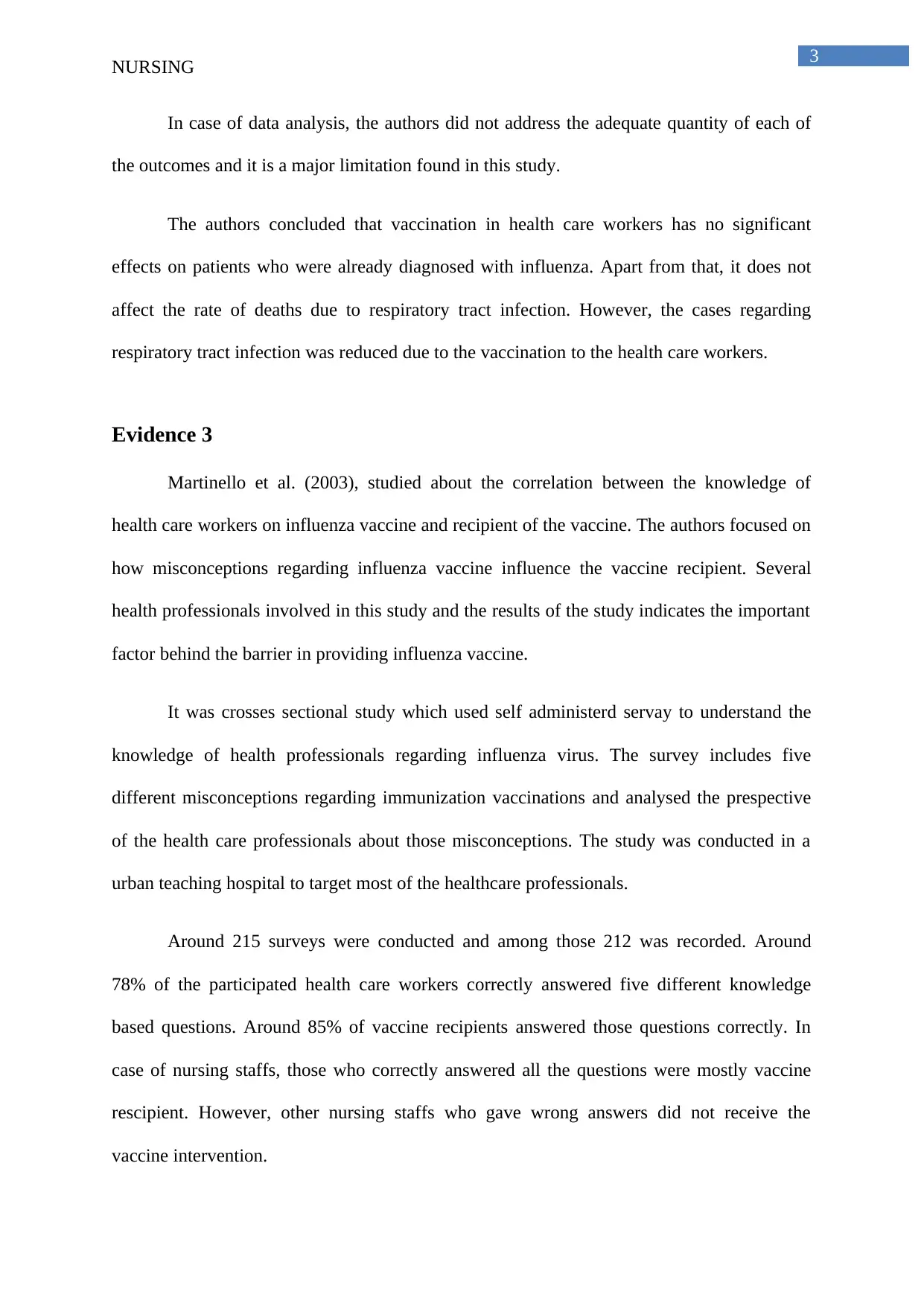
3
NURSING
In case of data analysis, the authors did not address the adequate quantity of each of
the outcomes and it is a major limitation found in this study.
The authors concluded that vaccination in health care workers has no significant
effects on patients who were already diagnosed with influenza. Apart from that, it does not
affect the rate of deaths due to respiratory tract infection. However, the cases regarding
respiratory tract infection was reduced due to the vaccination to the health care workers.
Evidence 3
Martinello et al. (2003), studied about the correlation between the knowledge of
health care workers on influenza vaccine and recipient of the vaccine. The authors focused on
how misconceptions regarding influenza vaccine influence the vaccine recipient. Several
health professionals involved in this study and the results of the study indicates the important
factor behind the barrier in providing influenza vaccine.
It was crosses sectional study which used self administerd servay to understand the
knowledge of health professionals regarding influenza virus. The survey includes five
different misconceptions regarding immunization vaccinations and analysed the prespective
of the health care professionals about those misconceptions. The study was conducted in a
urban teaching hospital to target most of the healthcare professionals.
Around 215 surveys were conducted and among those 212 was recorded. Around
78% of the participated health care workers correctly answered five different knowledge
based questions. Around 85% of vaccine recipients answered those questions correctly. In
case of nursing staffs, those who correctly answered all the questions were mostly vaccine
rescipient. However, other nursing staffs who gave wrong answers did not receive the
vaccine intervention.
NURSING
In case of data analysis, the authors did not address the adequate quantity of each of
the outcomes and it is a major limitation found in this study.
The authors concluded that vaccination in health care workers has no significant
effects on patients who were already diagnosed with influenza. Apart from that, it does not
affect the rate of deaths due to respiratory tract infection. However, the cases regarding
respiratory tract infection was reduced due to the vaccination to the health care workers.
Evidence 3
Martinello et al. (2003), studied about the correlation between the knowledge of
health care workers on influenza vaccine and recipient of the vaccine. The authors focused on
how misconceptions regarding influenza vaccine influence the vaccine recipient. Several
health professionals involved in this study and the results of the study indicates the important
factor behind the barrier in providing influenza vaccine.
It was crosses sectional study which used self administerd servay to understand the
knowledge of health professionals regarding influenza virus. The survey includes five
different misconceptions regarding immunization vaccinations and analysed the prespective
of the health care professionals about those misconceptions. The study was conducted in a
urban teaching hospital to target most of the healthcare professionals.
Around 215 surveys were conducted and among those 212 was recorded. Around
78% of the participated health care workers correctly answered five different knowledge
based questions. Around 85% of vaccine recipients answered those questions correctly. In
case of nursing staffs, those who correctly answered all the questions were mostly vaccine
rescipient. However, other nursing staffs who gave wrong answers did not receive the
vaccine intervention.
Paraphrase This Document
Need a fresh take? Get an instant paraphrase of this document with our AI Paraphraser
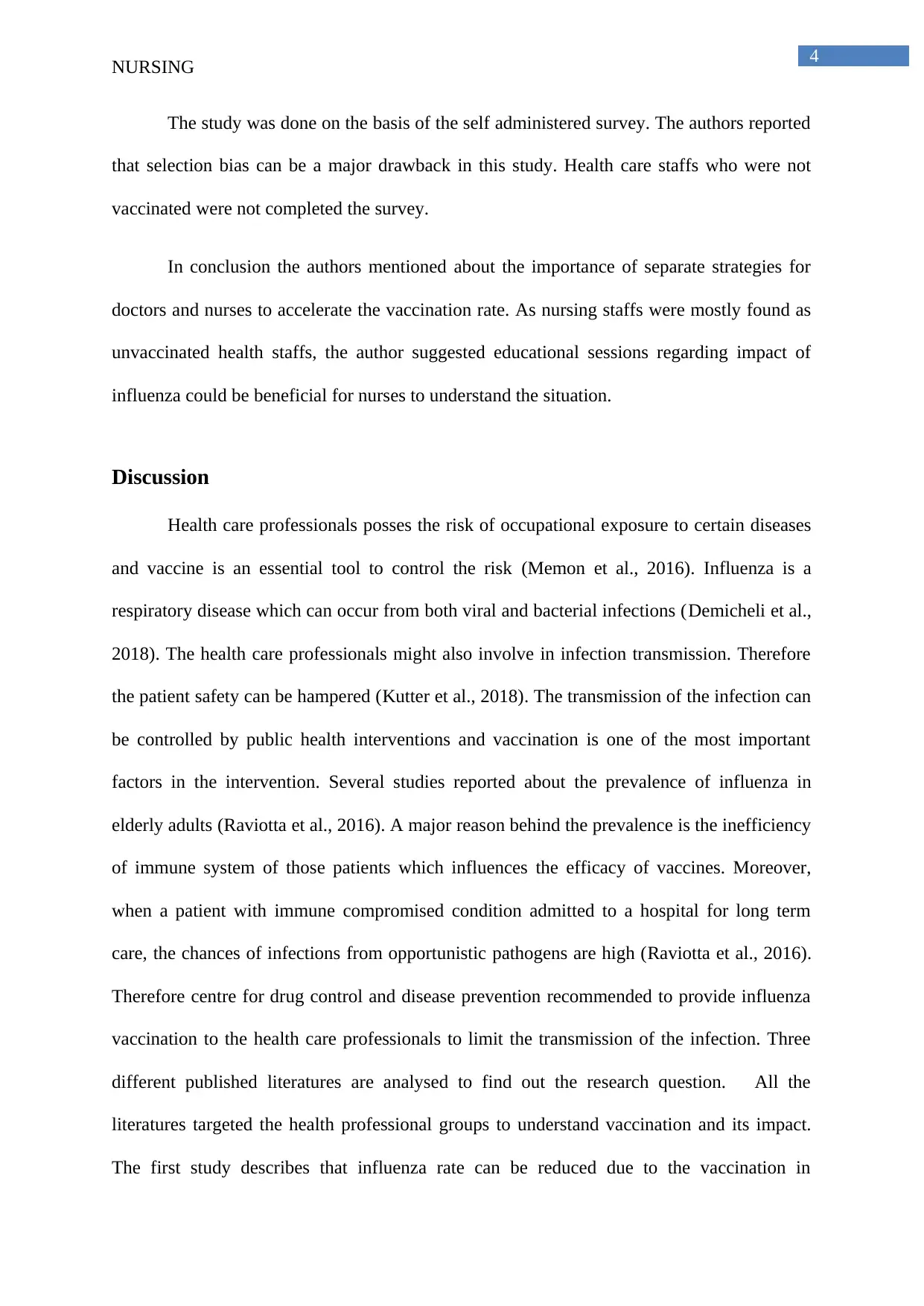
4
NURSING
The study was done on the basis of the self administered survey. The authors reported
that selection bias can be a major drawback in this study. Health care staffs who were not
vaccinated were not completed the survey.
In conclusion the authors mentioned about the importance of separate strategies for
doctors and nurses to accelerate the vaccination rate. As nursing staffs were mostly found as
unvaccinated health staffs, the author suggested educational sessions regarding impact of
influenza could be beneficial for nurses to understand the situation.
Discussion
Health care professionals posses the risk of occupational exposure to certain diseases
and vaccine is an essential tool to control the risk (Memon et al., 2016). Influenza is a
respiratory disease which can occur from both viral and bacterial infections (Demicheli et al.,
2018). The health care professionals might also involve in infection transmission. Therefore
the patient safety can be hampered (Kutter et al., 2018). The transmission of the infection can
be controlled by public health interventions and vaccination is one of the most important
factors in the intervention. Several studies reported about the prevalence of influenza in
elderly adults (Raviotta et al., 2016). A major reason behind the prevalence is the inefficiency
of immune system of those patients which influences the efficacy of vaccines. Moreover,
when a patient with immune compromised condition admitted to a hospital for long term
care, the chances of infections from opportunistic pathogens are high (Raviotta et al., 2016).
Therefore centre for drug control and disease prevention recommended to provide influenza
vaccination to the health care professionals to limit the transmission of the infection. Three
different published literatures are analysed to find out the research question. All the
literatures targeted the health professional groups to understand vaccination and its impact.
The first study describes that influenza rate can be reduced due to the vaccination in
NURSING
The study was done on the basis of the self administered survey. The authors reported
that selection bias can be a major drawback in this study. Health care staffs who were not
vaccinated were not completed the survey.
In conclusion the authors mentioned about the importance of separate strategies for
doctors and nurses to accelerate the vaccination rate. As nursing staffs were mostly found as
unvaccinated health staffs, the author suggested educational sessions regarding impact of
influenza could be beneficial for nurses to understand the situation.
Discussion
Health care professionals posses the risk of occupational exposure to certain diseases
and vaccine is an essential tool to control the risk (Memon et al., 2016). Influenza is a
respiratory disease which can occur from both viral and bacterial infections (Demicheli et al.,
2018). The health care professionals might also involve in infection transmission. Therefore
the patient safety can be hampered (Kutter et al., 2018). The transmission of the infection can
be controlled by public health interventions and vaccination is one of the most important
factors in the intervention. Several studies reported about the prevalence of influenza in
elderly adults (Raviotta et al., 2016). A major reason behind the prevalence is the inefficiency
of immune system of those patients which influences the efficacy of vaccines. Moreover,
when a patient with immune compromised condition admitted to a hospital for long term
care, the chances of infections from opportunistic pathogens are high (Raviotta et al., 2016).
Therefore centre for drug control and disease prevention recommended to provide influenza
vaccination to the health care professionals to limit the transmission of the infection. Three
different published literatures are analysed to find out the research question. All the
literatures targeted the health professional groups to understand vaccination and its impact.
The first study describes that influenza rate can be reduced due to the vaccination in

5
NURSING
healthcare. The second study supported the previous claim and also added that in case of
patients who are already detected with influenza, vaccination in did not have any significant
affect. The third study highlighted the fact that health care professionals often avoid influenza
vaccination. Respiratory infections are easily transferable. In case of immune suppressed
patients it can be severe. Influenza can cause severe conditions in elder adults. It can easily
transmit from health professionals to the patient and vice versa (Rashid et al., 2016).
Influenza vaccination on the other hand provides the protection from the infection. In case of
hospital set up, it is important to take additional precautions other than vaccines to prevent
the transmission. However, in centres with long term care, it is important to provide
vaccination to both the patient and health professionals. Aseptic conditions are necessary to
reduce the transmission of the infection. For example, if a patient with influenza is admitted
to the hospital and the health workers are already vaccinated, it is challenging for the microbe
to infect other persons. On the other hand, if both the patients and doctors are vaccinated with
influenza vaccination the chances of spred are significantly low. Therefore, prevention of the
disease can be possible. Apart from that, the third evidence highlighted the misconceptions
with influenza vaccinations within the health staffs. However, the study did not indicate the
whole population of health professionals around the globe, but it primarily indicated that
misconception can lead to make a barrier to restrict the prevention procedure (Kassianos,
2015). Therefore, it is important to provide information regarding influenza not only to the
health care workers but also to the other people. Proper information along with strong
policies can support the vaccination procedure to prevent the transmission of influenza (De
Serres et al., 2017).
Conclusion,
To conclude, the evidences supported the fact that influenza vaccination in health care
professionals can reduce the chances of infection transmission. Specifically in case of elderly
NURSING
healthcare. The second study supported the previous claim and also added that in case of
patients who are already detected with influenza, vaccination in did not have any significant
affect. The third study highlighted the fact that health care professionals often avoid influenza
vaccination. Respiratory infections are easily transferable. In case of immune suppressed
patients it can be severe. Influenza can cause severe conditions in elder adults. It can easily
transmit from health professionals to the patient and vice versa (Rashid et al., 2016).
Influenza vaccination on the other hand provides the protection from the infection. In case of
hospital set up, it is important to take additional precautions other than vaccines to prevent
the transmission. However, in centres with long term care, it is important to provide
vaccination to both the patient and health professionals. Aseptic conditions are necessary to
reduce the transmission of the infection. For example, if a patient with influenza is admitted
to the hospital and the health workers are already vaccinated, it is challenging for the microbe
to infect other persons. On the other hand, if both the patients and doctors are vaccinated with
influenza vaccination the chances of spred are significantly low. Therefore, prevention of the
disease can be possible. Apart from that, the third evidence highlighted the misconceptions
with influenza vaccinations within the health staffs. However, the study did not indicate the
whole population of health professionals around the globe, but it primarily indicated that
misconception can lead to make a barrier to restrict the prevention procedure (Kassianos,
2015). Therefore, it is important to provide information regarding influenza not only to the
health care workers but also to the other people. Proper information along with strong
policies can support the vaccination procedure to prevent the transmission of influenza (De
Serres et al., 2017).
Conclusion,
To conclude, the evidences supported the fact that influenza vaccination in health care
professionals can reduce the chances of infection transmission. Specifically in case of elderly
⊘ This is a preview!⊘
Do you want full access?
Subscribe today to unlock all pages.

Trusted by 1+ million students worldwide

6
NURSING
adults influenza can cause severe conditions which can lead to mortality. Hence, it is
important to reduce the risk of the transmission and vaccination in health professionals is an
efficient approach towards the prevention.
NURSING
adults influenza can cause severe conditions which can lead to mortality. Hence, it is
important to reduce the risk of the transmission and vaccination in health professionals is an
efficient approach towards the prevention.
Paraphrase This Document
Need a fresh take? Get an instant paraphrase of this document with our AI Paraphraser
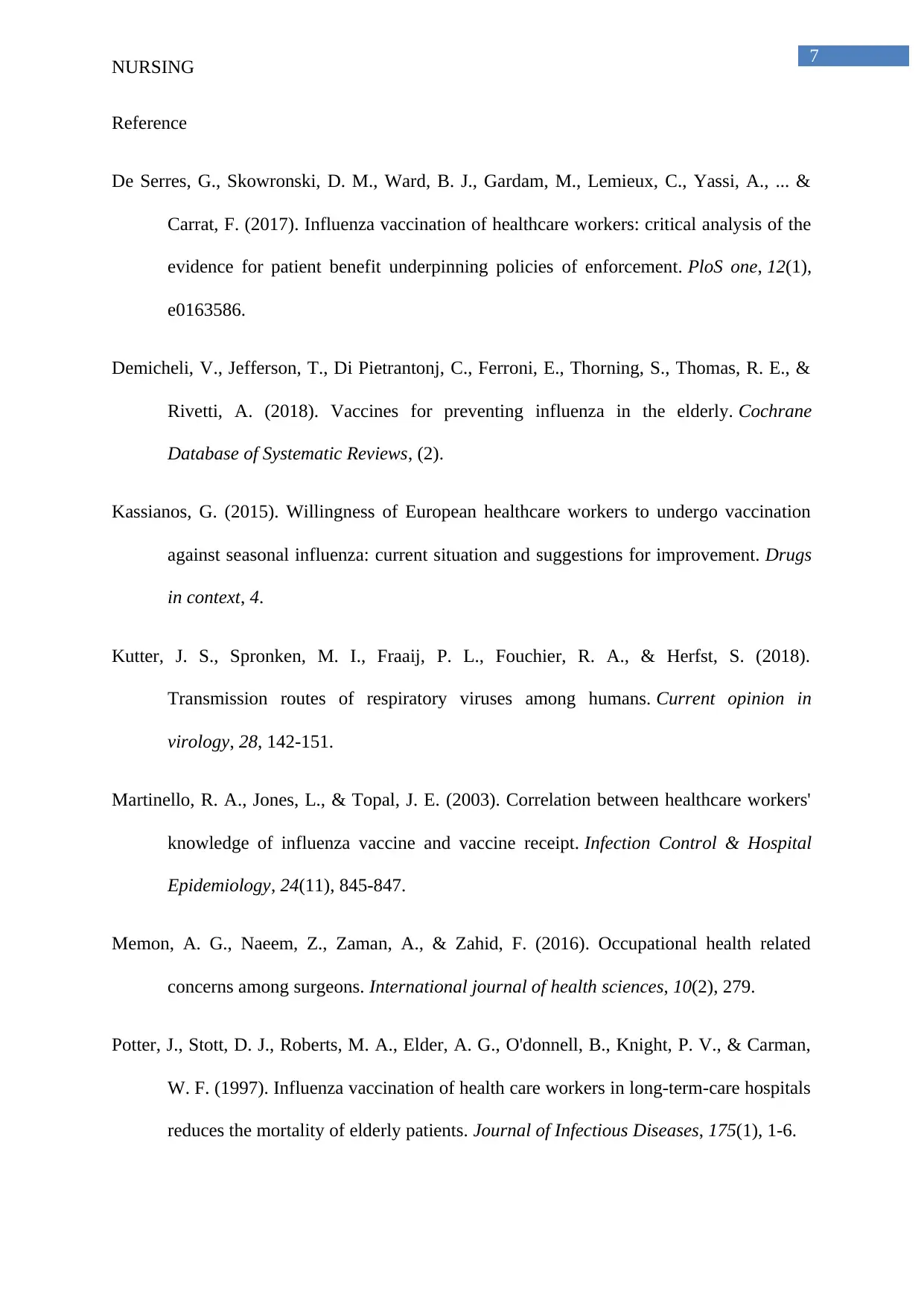
7
NURSING
Reference
De Serres, G., Skowronski, D. M., Ward, B. J., Gardam, M., Lemieux, C., Yassi, A., ... &
Carrat, F. (2017). Influenza vaccination of healthcare workers: critical analysis of the
evidence for patient benefit underpinning policies of enforcement. PloS one, 12(1),
e0163586.
Demicheli, V., Jefferson, T., Di Pietrantonj, C., Ferroni, E., Thorning, S., Thomas, R. E., &
Rivetti, A. (2018). Vaccines for preventing influenza in the elderly. Cochrane
Database of Systematic Reviews, (2).
Kassianos, G. (2015). Willingness of European healthcare workers to undergo vaccination
against seasonal influenza: current situation and suggestions for improvement. Drugs
in context, 4.
Kutter, J. S., Spronken, M. I., Fraaij, P. L., Fouchier, R. A., & Herfst, S. (2018).
Transmission routes of respiratory viruses among humans. Current opinion in
virology, 28, 142-151.
Martinello, R. A., Jones, L., & Topal, J. E. (2003). Correlation between healthcare workers'
knowledge of influenza vaccine and vaccine receipt. Infection Control & Hospital
Epidemiology, 24(11), 845-847.
Memon, A. G., Naeem, Z., Zaman, A., & Zahid, F. (2016). Occupational health related
concerns among surgeons. International journal of health sciences, 10(2), 279.
Potter, J., Stott, D. J., Roberts, M. A., Elder, A. G., O'donnell, B., Knight, P. V., & Carman,
W. F. (1997). Influenza vaccination of health care workers in long-term-care hospitals
reduces the mortality of elderly patients. Journal of Infectious Diseases, 175(1), 1-6.
NURSING
Reference
De Serres, G., Skowronski, D. M., Ward, B. J., Gardam, M., Lemieux, C., Yassi, A., ... &
Carrat, F. (2017). Influenza vaccination of healthcare workers: critical analysis of the
evidence for patient benefit underpinning policies of enforcement. PloS one, 12(1),
e0163586.
Demicheli, V., Jefferson, T., Di Pietrantonj, C., Ferroni, E., Thorning, S., Thomas, R. E., &
Rivetti, A. (2018). Vaccines for preventing influenza in the elderly. Cochrane
Database of Systematic Reviews, (2).
Kassianos, G. (2015). Willingness of European healthcare workers to undergo vaccination
against seasonal influenza: current situation and suggestions for improvement. Drugs
in context, 4.
Kutter, J. S., Spronken, M. I., Fraaij, P. L., Fouchier, R. A., & Herfst, S. (2018).
Transmission routes of respiratory viruses among humans. Current opinion in
virology, 28, 142-151.
Martinello, R. A., Jones, L., & Topal, J. E. (2003). Correlation between healthcare workers'
knowledge of influenza vaccine and vaccine receipt. Infection Control & Hospital
Epidemiology, 24(11), 845-847.
Memon, A. G., Naeem, Z., Zaman, A., & Zahid, F. (2016). Occupational health related
concerns among surgeons. International journal of health sciences, 10(2), 279.
Potter, J., Stott, D. J., Roberts, M. A., Elder, A. G., O'donnell, B., Knight, P. V., & Carman,
W. F. (1997). Influenza vaccination of health care workers in long-term-care hospitals
reduces the mortality of elderly patients. Journal of Infectious Diseases, 175(1), 1-6.
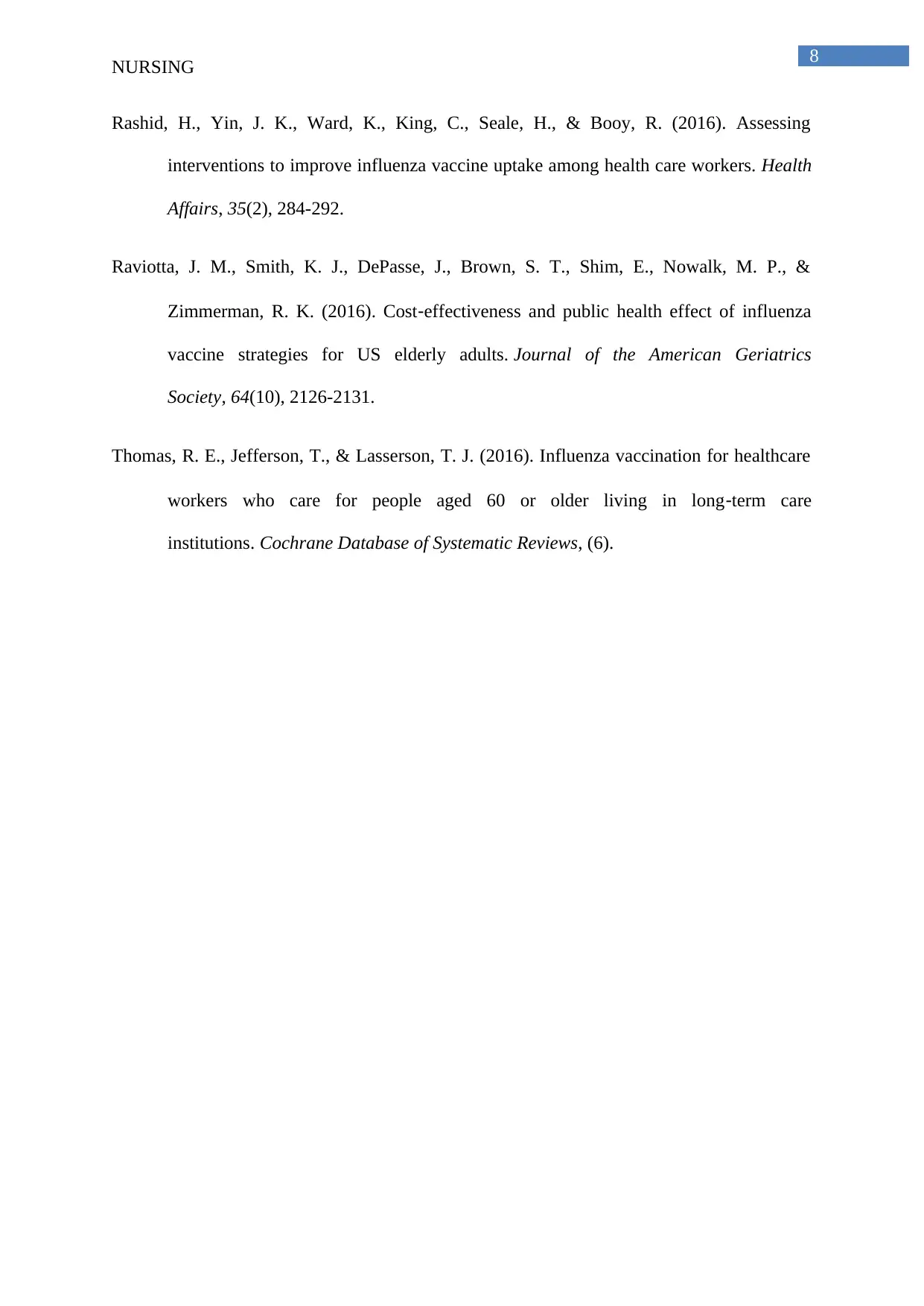
8
NURSING
Rashid, H., Yin, J. K., Ward, K., King, C., Seale, H., & Booy, R. (2016). Assessing
interventions to improve influenza vaccine uptake among health care workers. Health
Affairs, 35(2), 284-292.
Raviotta, J. M., Smith, K. J., DePasse, J., Brown, S. T., Shim, E., Nowalk, M. P., &
Zimmerman, R. K. (2016). Cost‐effectiveness and public health effect of influenza
vaccine strategies for US elderly adults. Journal of the American Geriatrics
Society, 64(10), 2126-2131.
Thomas, R. E., Jefferson, T., & Lasserson, T. J. (2016). Influenza vaccination for healthcare
workers who care for people aged 60 or older living in long‐term care
institutions. Cochrane Database of Systematic Reviews, (6).
NURSING
Rashid, H., Yin, J. K., Ward, K., King, C., Seale, H., & Booy, R. (2016). Assessing
interventions to improve influenza vaccine uptake among health care workers. Health
Affairs, 35(2), 284-292.
Raviotta, J. M., Smith, K. J., DePasse, J., Brown, S. T., Shim, E., Nowalk, M. P., &
Zimmerman, R. K. (2016). Cost‐effectiveness and public health effect of influenza
vaccine strategies for US elderly adults. Journal of the American Geriatrics
Society, 64(10), 2126-2131.
Thomas, R. E., Jefferson, T., & Lasserson, T. J. (2016). Influenza vaccination for healthcare
workers who care for people aged 60 or older living in long‐term care
institutions. Cochrane Database of Systematic Reviews, (6).
⊘ This is a preview!⊘
Do you want full access?
Subscribe today to unlock all pages.

Trusted by 1+ million students worldwide
1 out of 9
Related Documents
Your All-in-One AI-Powered Toolkit for Academic Success.
+13062052269
info@desklib.com
Available 24*7 on WhatsApp / Email
![[object Object]](/_next/static/media/star-bottom.7253800d.svg)
Unlock your academic potential
Copyright © 2020–2025 A2Z Services. All Rights Reserved. Developed and managed by ZUCOL.





